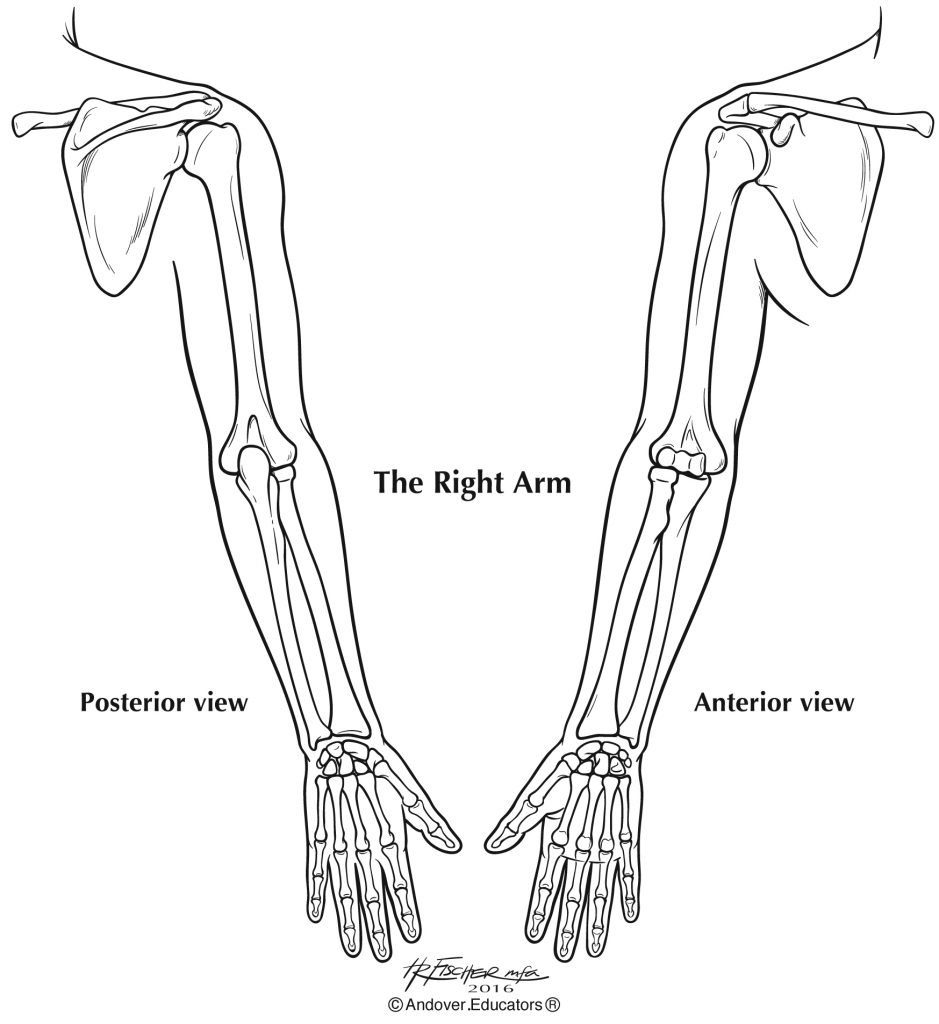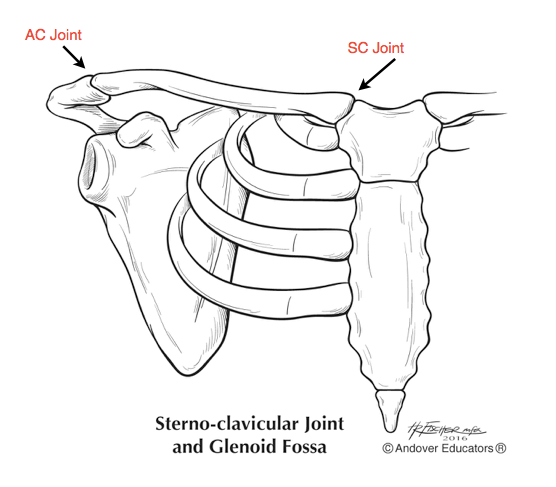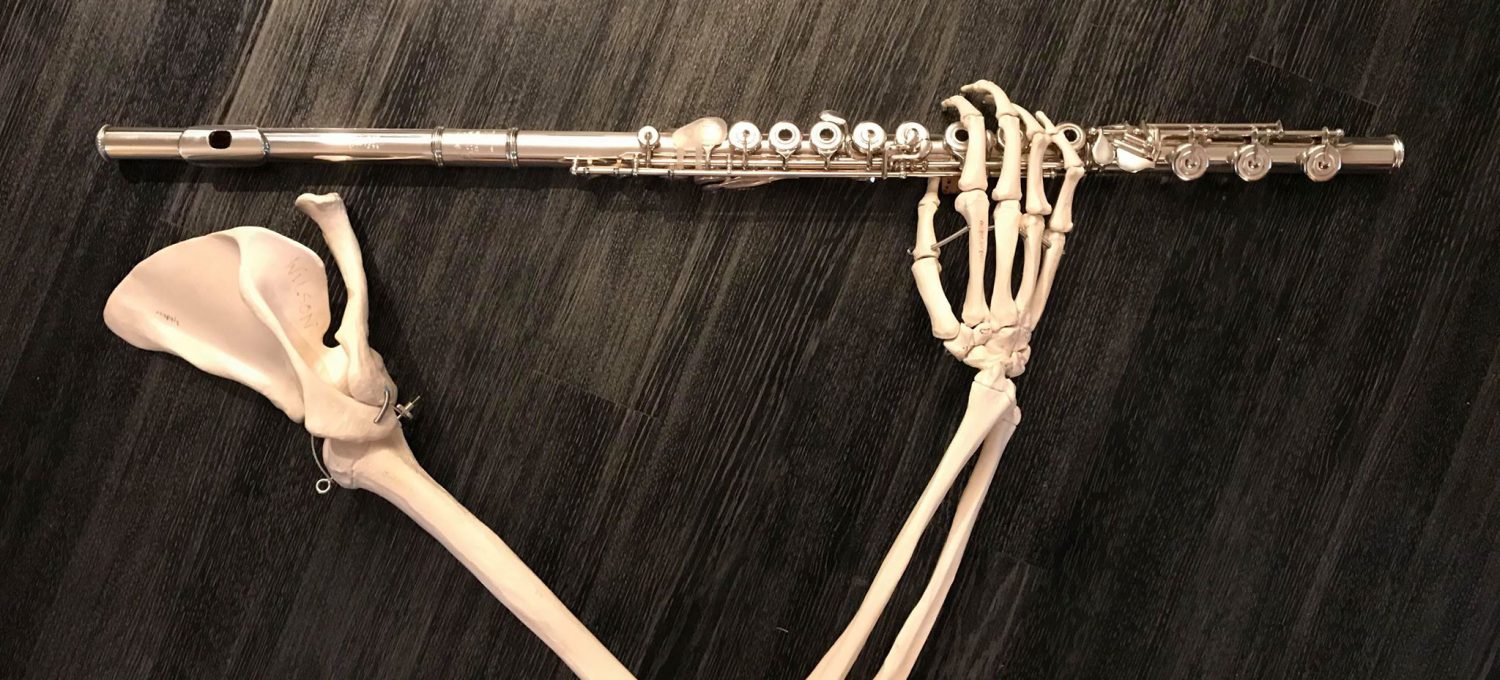I worked with some high school students at a summer camp earlier this summer and it was no surprise to me that several of them were already dealing with pain in their hands, wrists or forearms. All of them wanted to learn everything they could about how to improve their technical facility. Fortunately, some accurate information about how arms work can help address both of these situations.
The first question to ask is what pieces make up an entire arm? Everybody knows that the hand is one end, but where is the other end? When asked to point, these high school students pointed to various places on their upper arm. When looking at my skeletal model of an arm, it immediately became apparent that arms are longer than they seem. A whole arm is made up of a hand, a wrist, two forearm bones, an upper arm bone, a collarbone (clavicle) and a shoulder blade (scapula). If you haven’t mapped your collarbones and shoulder blades as being part of your arm structure, now is the time to start! The movement that happens here is just as important as the movement happening in the hands when considering the quality of arm movement as a whole.

Next step —- Palpation
Palpation, which means explore by touch, is a great way to get information about your whole arm structure. Start with your right arm up with your palm facing your face. With your left hand fingers, trace your entire arm. Begin with your right pinky finger, trace along your hand, to your wrist, along your forearm, passing over your elbow, then upper arm, down through your armpit and all the way to the bottom of your shoulder blade. Then trace your left arm structure using your right hand fingers.
Why is the collarbone so important?
How and where does this whole arm structure attach to the rest of the skeleton with a bone to bone connection? There is only one place and it’s called the sternoclavicular (SC) joint, which is located where the clavicle (collarbone) meets the sternum in front. Arms hook on, bone wise, only in the front! Yes, the shoulder blades are attached through fasica, connective tissue and muscles to other bones, but there is no “shoulder blade joint” with the skeleton.

Back to palaption — find the sternal notch which is the little hollow indentation between the two collarbones. Take your left hand fingers, start from this notch, and walk your fingers along the length of your right collarbone. You’re starting from the middle and walking out towards your arm pit. Do this several times until you’re very clear about where your collarbone is located. To find the SC joint itself, start at the notch and go over the little hump onto the collarbone…. that’s the joint itself. Next, make a collarbone sandwich by placing your left index finger on top of your right collarbone and your middle finger underneath your collarbone. The SC joint should be under the palm of your left hand. Maintain this hand position for the following movement explorations. There are several kinds of movement that can happen at the SC joint. The first is up & down, like shrugging your shoulder up toward your ear. The second type of movement is forward & back, like a trombone player reaching out all the way to 7th position. The third type of movement available to us at the SC joint is rotation. Do some swimming movements with your right arm and you’ll feel the collarbone rotating under your left hand. Reverse the direction of your swimming movement – if you started with front crawl, then switch to back crawl. These three basic movements can be combined in many different ways. When your fingers are in motion, there should be some type of movement, maybe very subtle, at the SC joint. With your collarbone sandwich still in place, pretend you’re shaking hands with someone. Notice that there’s not a ton of movement happening at your SC joint. Now reach up in front like you’re getting something off of a high shelf – there’s more movement now. How about reaching down and behind you, as if you’re reaching for your sunglasses after you dropped them down behind the driver’s seat of your car? Pretend to hold a glass of water in your right hand and pour it out on your right foot – not a lot of SC joint movement. However, if you pour that glass of water out onto your left foot, there’s much more movement happening.
Release your collarbone sandwich and just let your arms hand at your sides. Do you feel a difference between your right and left arms? It’s not unusual for people to report that their right arm feels longer, looser, or softer. Repeat all of these movement explorations with your left arm — so right hand fingers will be sandwiching the left collarbone.
Did you notice what was happening to your shoulder blade while you were exploring SC joint movement at your collarbone?
If you were totally focused on your collarbone and have no idea what you shoulder blade was doing, then repeat the movement explorations and notice how your shoulder blade moves along with your collarbone. It should because they are attached at a joint called the acromioclavicular (AC) joint. For our purposes here, we don’t need to know a whole lot about what’s happening at the AC joint. What would your movement be like if you thought your shoulder blades were not supposed to move or if you thought they were attached to your ribs with screws, like they are on skeletal models? Try it — can you do it? Do you feel the extra work and tension that you generate?
With bringing your flute up into playing position, notice that your collarbones and shoulder blades are doing different things. Your left collarbone and shoulder blade come more around your body than your right side. This makes sense because our left arm crosses in front of our torso and our right arm really needs to just move forward towards the flute.
To really explore this movement, bring your flute to your face from above your head. Finger middle D and then float your flute over and down to your face. Feel how much your left shoulder blade and collarbone can move if you allow them this freedom.
Here’s my last tidbit about the collarbone and shoulder blades—what they are doing impacts the quality of your breathing!
There will be more about this in future articles, but for now, please try this movement exploration. Take your collarbones and shoulder blades and jam them down onto your ribs. Keep them there and try to take a breath. Notice the effort you need to use and the amount of air you get in. Release your arm structure and allow it to move up off your ribs and take another breath. Hopefully, you noticed an easier, freer, fuller breath. As my friend and colleague Amy Likar says,
“The arm structure should surf the movement of the ribs.”
You can take your new awareness of your SC joints and the movement possibilities of your collarbones and shoulder blades into all sorts of activities. Movement is movement. Notice what you’re doing when you’re driving, when your working on your computer, or simply brushing your teeth. The body you live in is the same body in which you perform and you can constantly be working on it. If you have specific topics that you would like to know more about, please email me at kmollnow@mac.com.


[…] whole arm movement involving the Sterno-clavicular joint (see this article for more info – https://thefluteexaminer.com/missing-pieces-of-the-whole-arm/) in the front and full range of motion for both shoulder blades, many musicians find that some of […]
[…] to pause here and go read my article “Missing Pieces of the Whole Arm” from September, 2018 [https://thefluteexaminer.com/missing-pieces-of-the-whole-arm/], as it explains about the importance of the collarbone and shoulder […]